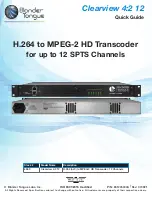
Document 2.4.126, Revision 4
October 2017
12
Three-Phase Padmounted Distribution Transformers
Pre-Energization Inspection and Tests
After the transformer has been installed, but before
it is energized, the following tests and checks
should be performed at a minimum to ensure that
the transformer is ready to be energized. Do not
energize the transformer without performing these
tests and checks.
1.
Ratio Test
—Using a transformer turns ratio
tester (TTR), perform a ratio test to verify
the primary-to-secondary winding ratio.
The measured value should be within
0.5% of the voltage ratio indicated on the
transformer nameplate. If the transformer
is supplied with high-voltage taps, measure
the ratio at each tap position to ensure
that each of the ratios is correct. Follow the
instructions and safety precautions provided
by the TTR equipment manufacturer. For
additional information about ratio testing,
refer to IEEE Standard C57.12.90.
2.
Insulation Resistance Test
— Perform a
1,000-Volt insulation test (Megger test) to
measure the resistance of the insulation
between windings and from each winding
to ground. Follow the instructions and
safety precautions provided by the test
equipment manufacturer. Prior to the test,
bushings must be thoroughly cleaned with
denatured alcohol to remove any moisture
or contaminates that could influence the
test results. Measured resistance should be
at least 1.0 GΩ.
An insulation resistance test must not
be performed on a wye-wye connected
transformer with an Ho-Xo bushing without
first disconnecting the internal connection
between the primary and secondary
neutrals. This connection can be found on a
terminal board located below the fluid level
in the transformer tank. Refer to “Opening
the Transformer Tank” for instructions.
3.
Tap Changer Setting
—Check the tap
changer setting to ensure it is set to the
proper position for the required voltage.
SECTION 4: INSPECTION AND TESTING BEFORE AND
AFTER INITIAL ENERGIZATION
FAILURE TO FOLLOW THE INSTRUCTIONS
BELOW WILL RESULT IN DEATH OR SERIOUS
PERSONAL INJURY, AND DAMAGE TO THE
EQUIPMENT.
• Energize the transformer from a remote
location.
• Do not energize the transformer using
single-phase switches or fuses. Use only
gang-operated three-phase switches to
energize a three-phase transformer.
• Do not operate the transformer with any
of the primary phases open.
• Only qualified personnel with appropriate
equipment should measure transformer
voltages.
• Be aware of dangerous voltages within
the terminal compartment and avoid
personal contact with live terminals.
• Wear personal protective equipment to
prevent injury from potential arc-flash or
contact with dangerous voltages.
• Make sure the transformer is properly
grounded at all times.
• Insulated dead-end caps or plugs must
be installed on all unused dead-front
high-voltage bushings. Dust caps must
not be used in place of insulated dead-
end caps or plugs.
• Current transformer (CT) leads must
be connected to the metering load
or shorted together and grounded to
prevent dangerous voltages at the CT
terminals.
DANGER













































